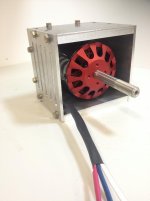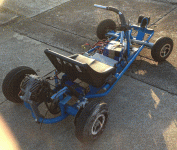GeorgeJpindustries
100 µW
- Joined
- Jul 4, 2014
- Messages
- 7
The drift trike

http://youtu.be/_TmlYlsgw1Q
http://youtu.be/c41pqhck4Lk
http://youtu.be/gKK7sdO6Jks
http://youtu.be/YpIt9cNQSPA
The go kart
[ATTACH type="full" alt="IMG_2226.gif[/attachment
Well , these two and three scooters , and a mower ( no pictures of those yet , sorry) are the living proof that Lundell alternator can be used as a motor reliably , efficiently , and best of all cheaply .
.
Best way to share my observations is through a comparison with something we all know - 80/100 outrunners.
So here is a list of pros and cons (it took me few years of bittersweet experience to come to these conclusions).
Turnigy outrunner:
Pros:
-small and light
-torquey and powerful (2kw continuous in Australian summer is a max. though)
-reasonably efficient (thin stator laminations - better for high rpm)
-cheap
Cons:
-structurally weak (it must be mounted on a plate with auxiliary support bearing)
-needs to be rewound with high temp wire
-12mm shaft
-low inductance and resistance , which makes it hard on the controller
-high KV , even when terminated in wye and more turns than original
-noisy ( I personally like the noise)
Couple of pictures of probably the most elaborate 80/80 outrunner box in history
[attachment=1]8080.jpg"]2[/ATTACH]

Alternators
Pros:
-bullet proof (designed to run at 15000rpm)
-massive bearings, and only two of them , not five like the outrunner(including the support one)
-no magnets - no risk of overheating and cooking them
-possibility of field weakening(from my experience this is only partially useful)
-more controller friendly inductance and resistance values
-low KV ( the one on the trike is about 40KV)
-good thermal mass , all aluminium too
-17mm shaft or bigger
-torque , even from mechanical standpoint, the one on the kart has a rotor diameter of 97mm compared to 80mm of the outrunners outer can
-silent running , even sensorless.
-well suited for high temperature operation
-cheaper (I have unlimited supply of free alts. )
)
Cons:
-relatively big and heavy
-only some of them have stator laminations thin enough to be viable as a motor
-energizing the field consumes power (30-60w) , and it has to be around 12v (I have dc-dc converters on all my vehicles anyway though)
-the shaft is too short sometimes
-slip rings with brushes
Plus then there`s the argument of outrunner vs inrunner , but that`s irrelevant , because I use both of these motor configurations , depending on application suitability.
So how do I convert an alt? Here is step by step of what I do:
1.Identify a suitable alt. (ideally one with the lams exposed, to measure the thickness)
2.I rip off the rectifier (not always possible , because the brush holder is sometimes integral with the assembly) , exposing the phase wires.
3.Re-terminate in wye (unless already is), don`t bother with delta, trust me.
4.Solder wires DIRECTLY to the ends of the field exciting brushes, bypassing the voltage regulator. Reason to do this is, the back - emf voltage spikes induced into the rotor by the controller will over short time kill the regulator. Trust me, I know , this was a major headache for me when trying to make this to be reliable. Don`t worry, the field coil`s resistance will keep the current at about 3-4 amps at 12v.
5.Solder cables of equal length to the phase terminations.
6.Hook up to sensor-less controller , field coil directly to 12v supply and there is your motor.
Some observations:
I only run these sensor-less , with 12 fet e-crazyman controllers , that I fitted out with some decent silicon and capacitance and current set at 40/80,on the trike, it never looses sync , even starting from standstill uphill and going full throttle straight up. It just spins the wheel and takes off.
The trike runs 15s li-ion battery so fully charged , with voltage sag of 4v - about 2.3kw . It can run all day full stick , regardless of temperature , pulls like steam train , and heating of the altermotor is minimal. I`d estimate the efficiency of that particular alt. at 85%.
The one on the kart is worse however, running 24fet 4110 controller at 55/125A at 24s a123 lifepo4. At full charge that`s about 4.7kw , but from what i know , it only feels like 3.5kw is being transferred into mechanical work. Heating of that motor is pretty bad (it has zero airflow however). The kart still flies though .
.
When choosing the alt. and it says 14v 105a for example , you`ll be able to feed it about 75A of phase current (70%) , 40 A battery,reliably in all weather conditions.
As you can see it really depends which one you pick to convert , newer Mitsubishi alts ,for example ,have two sets of three phases ( maybe 6 phase stator or double wye , i don`t know), but they have very thin lams (0.28mm) and massive stator width (50mm+) , 120mm rotor diameter and utilizing rectangular wire for maximum copper fill ,so worth investigating further.
Voltage over amperage every time.
Some of these have only single 1.6mm wire coming out of each phase ,after I terminate the stator in wye, limiting the current.
The xiechang controllers have very easy time driving these motors.
Result is virtually bulletproof system,both mechanically and electrically.
In conclusion , these motors are great if you`re on a budget , or just building a toy for fun, and the best efficiency is not you primary criteria.

http://youtu.be/_TmlYlsgw1Q
http://youtu.be/c41pqhck4Lk
http://youtu.be/gKK7sdO6Jks
http://youtu.be/YpIt9cNQSPA
The go kart
[ATTACH type="full" alt="IMG_2226.gif[/attachment
Well , these two and three scooters , and a mower ( no pictures of those yet , sorry) are the living proof that Lundell alternator can be used as a motor reliably , efficiently , and best of all cheaply
Best way to share my observations is through a comparison with something we all know - 80/100 outrunners.
So here is a list of pros and cons (it took me few years of bittersweet experience to come to these conclusions).
Turnigy outrunner:
Pros:
-small and light
-torquey and powerful (2kw continuous in Australian summer is a max. though)
-reasonably efficient (thin stator laminations - better for high rpm)
-cheap
Cons:
-structurally weak (it must be mounted on a plate with auxiliary support bearing)
-needs to be rewound with high temp wire
-12mm shaft
-low inductance and resistance , which makes it hard on the controller
-high KV , even when terminated in wye and more turns than original
-noisy ( I personally like the noise)
Couple of pictures of probably the most elaborate 80/80 outrunner box in history
[attachment=1]8080.jpg"]2[/ATTACH]

Alternators
Pros:
-bullet proof (designed to run at 15000rpm)
-massive bearings, and only two of them , not five like the outrunner(including the support one)
-no magnets - no risk of overheating and cooking them
-possibility of field weakening(from my experience this is only partially useful)
-more controller friendly inductance and resistance values
-low KV ( the one on the trike is about 40KV)
-good thermal mass , all aluminium too
-17mm shaft or bigger
-torque , even from mechanical standpoint, the one on the kart has a rotor diameter of 97mm compared to 80mm of the outrunners outer can
-silent running , even sensorless.
-well suited for high temperature operation
-cheaper (I have unlimited supply of free alts.
Cons:
-relatively big and heavy
-only some of them have stator laminations thin enough to be viable as a motor
-energizing the field consumes power (30-60w) , and it has to be around 12v (I have dc-dc converters on all my vehicles anyway though)
-the shaft is too short sometimes
-slip rings with brushes
Plus then there`s the argument of outrunner vs inrunner , but that`s irrelevant , because I use both of these motor configurations , depending on application suitability.
So how do I convert an alt? Here is step by step of what I do:
1.Identify a suitable alt. (ideally one with the lams exposed, to measure the thickness)
2.I rip off the rectifier (not always possible , because the brush holder is sometimes integral with the assembly) , exposing the phase wires.
3.Re-terminate in wye (unless already is), don`t bother with delta, trust me.
4.Solder wires DIRECTLY to the ends of the field exciting brushes, bypassing the voltage regulator. Reason to do this is, the back - emf voltage spikes induced into the rotor by the controller will over short time kill the regulator. Trust me, I know , this was a major headache for me when trying to make this to be reliable. Don`t worry, the field coil`s resistance will keep the current at about 3-4 amps at 12v.
5.Solder cables of equal length to the phase terminations.
6.Hook up to sensor-less controller , field coil directly to 12v supply and there is your motor.
Some observations:
I only run these sensor-less , with 12 fet e-crazyman controllers , that I fitted out with some decent silicon and capacitance and current set at 40/80,on the trike, it never looses sync , even starting from standstill uphill and going full throttle straight up. It just spins the wheel and takes off.
The trike runs 15s li-ion battery so fully charged , with voltage sag of 4v - about 2.3kw . It can run all day full stick , regardless of temperature , pulls like steam train , and heating of the altermotor is minimal. I`d estimate the efficiency of that particular alt. at 85%.
The one on the kart is worse however, running 24fet 4110 controller at 55/125A at 24s a123 lifepo4. At full charge that`s about 4.7kw , but from what i know , it only feels like 3.5kw is being transferred into mechanical work. Heating of that motor is pretty bad (it has zero airflow however). The kart still flies though
When choosing the alt. and it says 14v 105a for example , you`ll be able to feed it about 75A of phase current (70%) , 40 A battery,reliably in all weather conditions.
As you can see it really depends which one you pick to convert , newer Mitsubishi alts ,for example ,have two sets of three phases ( maybe 6 phase stator or double wye , i don`t know), but they have very thin lams (0.28mm) and massive stator width (50mm+) , 120mm rotor diameter and utilizing rectangular wire for maximum copper fill ,so worth investigating further.
Voltage over amperage every time.
Some of these have only single 1.6mm wire coming out of each phase ,after I terminate the stator in wye, limiting the current.
The xiechang controllers have very easy time driving these motors.
Result is virtually bulletproof system,both mechanically and electrically.
In conclusion , these motors are great if you`re on a budget , or just building a toy for fun, and the best efficiency is not you primary criteria.


